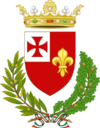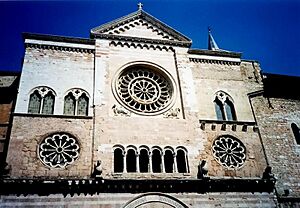Foligno facts for kids
Quick facts for kids
Foligno
Fuligno
|
|||
|---|---|---|---|
| Città di Foligno | |||

Foligno aerial view
|
|||
|
|||
| Country | Italy | ||
| Region | Umbria | ||
| Province | Perugia (PG) | ||
| Frazioni | See list | ||
| Area | |||
| • Total | 263 km2 (102 sq mi) | ||
| Elevation | 234 m (768 ft) | ||
| Population
(31 August 2017)
|
|||
| • Total | 56,918 | ||
| • Density | 216.4/km2 (560.5/sq mi) | ||
| Demonym(s) | Folignati or Fulginati | ||
| Time zone | UTC+1 (CET) | ||
| • Summer (DST) | UTC+2 (CEST) | ||
| Postal code |
06034, 06030, 06037
|
||
| Dialing code | 0742 | ||
| Patron saint | St. Felician Martyr | ||
| Saint day | January 24 | ||
Foligno (pronounced fo-LEEN-yo) is an old town in central Italy. It's located in the Umbria region, near the Topino river where it leaves the mountains and flows into a wide plain. Foligno is about 40 kilometers (25 miles) southeast of Perugia.
This town is an important center for trains, with repair and maintenance yards for trains in central Italy. Because of this, it was heavily bombed during World War II. This is why many parts of Foligno look modern today, even though it still has some old buildings. The city's location in the plain and its good train connections have led to it growing a lot. Foligno is also an important road junction in central Italy and has a small airport nearby.
Contents
History of Foligno
Foligno was likely founded by the Umbrians around the 8th century BC, long before the Romans. The Romans took control of it in 295 BC and called it Fulginiae. It became an important stop along the ancient Via Flaminia, a major Roman road.
After the Roman Empire fell, the city faced tough times. It was attacked by different groups, like the Saracens in 881 and the Magyars in 915 and 924. Because of these attacks, people moved to a nearby church area called Civitas Sancti Feliciani, which was protected by walls. This new location grew and became the Foligno we know today.
Foligno became a free city in 1165. For a while, it was a rival of Perugia. In 1305, a powerful family called the Trinci took control. During their rule, especially in the 1400s, Foligno became very rich and a center for art. The Trinci family supported many artists, and their palace, the Palazzo Trinci, shows this.
In 1439, the Trinci family went against the Papal States (lands ruled by the Pope). The Pope sent an army, and Foligno became part of the Papal States until 1860. The city was briefly part of the French Empire during the time of Napoleon. Later, the people of Foligno helped in the Risorgimento wars, which led to Italy becoming a united country. In 1860, Foligno joined the Kingdom of Italy.
Foligno has also experienced several big earthquakes, including ones in 1832 and 1997.
Main Sights to See
Foligno has many interesting places to visit:
- Palazzo Comunale (Town Hall): This building was first built in the 1200s and rebuilt several times. Its current look is from the 1800s, but its bell tower is still the original from the 13th century.
- Palazzo Orfini: Next to the Town Hall, this Renaissance-style building is famous because the first printing shop in Foligno opened here around 1470. In April 1472, the first book printed in the Italian language, Dante's Divine Comedy, was made here by Johann Neumeister.
- Cathedral of San Feliciano or Duomo: This is the main church, built between 1133 and 1201 in a Romanesque style. The inside was redone in the 1700s.
- Santa Maria Infraportas: This is the oldest church in town, though the building you see today is from the 11th century.
- Trinci Palace (Palazzo Trinci): Built between 1389 and 1407, this palace now holds an archaeological museum, the city's art gallery, and a museum about tournaments. It has beautiful frescoes from the early 1400s, some possibly by the famous artist Gentile da Fabriano.
- Oratory of Nunziatella: This Renaissance-style building was built after a special event in 1489. It has a famous painting called "Baptism of Jesus" by Perugino from 1507. You can also see the actual printing press that was used to print the first edition of Dante's Divina Commedia in 1472.
Culture and Art
Foligno was known for a special style of painting in the 1400s. The famous painting Madonna of Foligno by the artist Raphael was painted for a nobleman from Foligno.
As mentioned, the very first printed edition of Dante's famous poem, Divina Commedia, was printed right here in Foligno in 1472. This was a huge moment in history for books!
The city is also the birthplace of St Angela of Foligno (1248–1309), a well-known mystic and saint.
City Quarters and the Quintana Joust
Foligno's historic center is divided into twenty rioni (quarters). Ten of these quarters are officially recognized and take part in a special event called the Giostra della Quintana.
The Giostra della Quintana is a knight's jousting tournament based on a historical event. It happens twice a year: once in June and again in September. The word "Quintana" comes from the name of a road in ancient Roman military camps where soldiers trained for lance fighting. They would practice by riding against a dummy soldier and trying to catch a ring.
The first time a "Quintana" joust was officially recorded as part of a festival was in 1448. In the modern tournament, ten knights, each representing one of the city's quarters, ride at a gallop. They have to catch three rings, which get smaller each time, hanging from a rotating statue of Mars, the Roman God of War. This statue is made of oak and dates back to 1613!
The day before the joust, the whole town gets involved in a parade with 800 people dressed in beautiful, old-fashioned costumes. It's a big celebration for Foligno!
Notable People from Foligno
- Angela of Foligno (1248–1309), a saint known for her spiritual writings.
- Niccolò Alunno (born 1430), an important Italian painter.
- Antimo Liberati (born 1617), an Italian music expert, composer, and singer.
- Caterina Scarpellini (1808–1873), a famous astronomer.
- Leonardo Spinazzola (born 1993), a professional football player for the Italy national football team.
International Connections
Foligno has "twin town" or "sister city" relationships with other cities around the world. This means they share culture and friendship.
Foligno is twinned with:
 Gemona del Friuli, Italy
Gemona del Friuli, Italy La Louvière, Belgium
La Louvière, Belgium Shibukawa, Japan
Shibukawa, Japan





